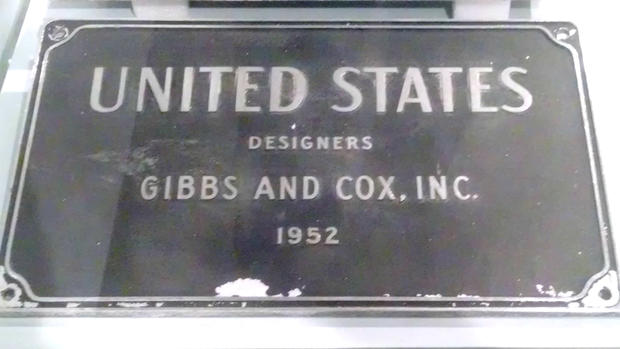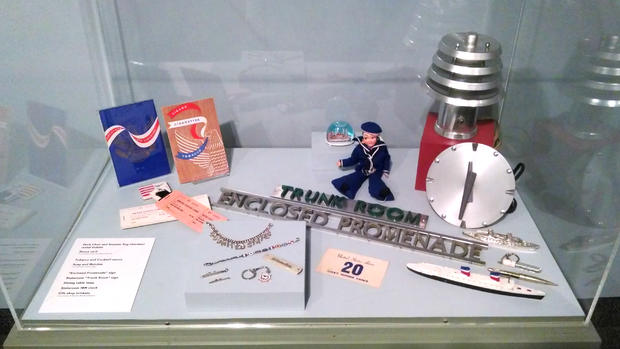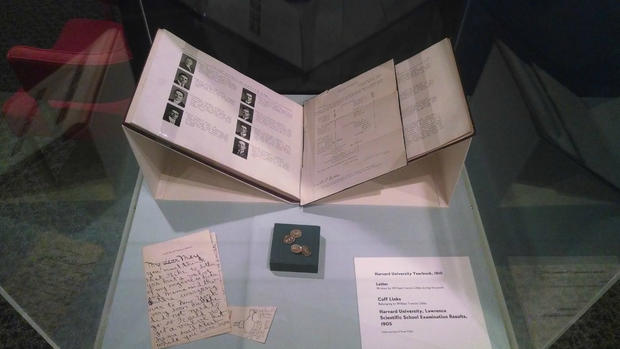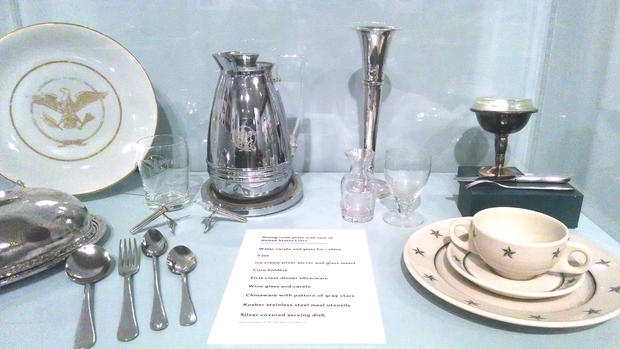Hear Philly: Discover America's Flagship At The Seaport Museum
By Tom Rickert
PHILADELPHIA (CBS) --- This ship has a lot of stories to tell.
Her name is the SS United States, and she spent the better part of two decades as America's Flagship, breaking speed records across the Atlantic Ocean, and serving as the luxurious temporary home to many famous travelers.
Now, she has her very own exhibit at the Independence Seaport Museum.
"Probably everyone's seen the SS United States from the highway, docked down across from IKEA," said Craig Bruns, chief curator at the museum. "It's a big, big beautiful ship, and they're probably wondering what that ship is. And this is the place to find out."
The SS United States is a passenger liner built in 1952. Unlike the cruise ships of today, passenger liners were built for point A to point B transportation. They were in a large part made defunct by airlines in the later decades of the 1900s, but you would find no cramped seats and soggy sandwiches on a passenger liner - booking a ride on the SS United States was truly a splendid way to travel.
"We all know the Titanic," Bruns says. "We've all seen the movie and the splendors of what it was like to be aboard. If you think about Titanic, Titanic was very fancy, very much of its time, early 20th century. If we think about the United States, built in the 1950s, that fanciness wasn't popular then. What was popular was modernism, and so the ship was a great example of modernism at the time."
The examples of decorations, trinkets, and tools from the ship on display represent the mid-century design of the time, design which has come full circle since then! The decorations from the ship, made 60 years ago, would not look out of place in a modern setting. The silver tea sets, snow globe picturing the ship in front of a New York skyline, and the charm bracelets with the name of the ship spelled out in colorful beads could all be seen or used today without a second glance. These do not look like antiques.
"Today, mid-century design is very popular," Bruns agrees. "It's a resurgence of modernism from an earlier part of the century; it is a design that looks very familiar to us. But if you start to look at the dates, you see that, 'oh, my grandmother probably had this in her living room,' and that's the way style happens. Things fall out of favor and they return and once again become in favor."
The exhibit is not just an example of fashion's cyclical nature, however. It's very much a Philadelphia story. While the SS United States was built in Newport News, Virginia, it has its conceptual roots in Philadelphia, designed by a man named William Francis Gibbs.
"Probably a lot of people don't know about William Francis Gibbs, the man who designed the ship," says Bruns. "He grew up here in Philadelphia. When he was an 8 year old, he went to Cramp [& Sons] shipyard, in the Kensington section along the river on Aramingo, and he saw a ship being launched. And he was amazed, an 8 year old, and these ships were huge! And they went sliding on down into the river. So from then on he could think of nothing else than ships."
Gibbs would never grow out of his obsession with ships, and many years later he would design a ship that would be launched from the very same shipyard he hung out at as an 8 year old, the SS Malolo.
The United States was designed with several purposes in mind. The primary purpose was, of course, as a passenger liner making trips across the Atlantic Ocean. Another possible function for the ship enabled builders to secure funding from the United States government.
"The armed forces partially funded the building of the ship, because it could be later used as a troop ship, in case we went to war," says Bruns. "It could be easily transformed into a troop ship. And there's a little bit of history in that, because in the past, great passenger liners were transformed into troop ships. The Queen Elizabeth and the Queen Mary were transformed. And so they looked at history and saw this had been done before - let's make preparations for it this time."
The SS United States was very popular, and for 17 years it was a luxurious way to travel across the Atlantic. It also happened to fall victim to the technological progress that occurred in the 1960s.
"What happened in the ensuing years was airline flight became more and more popular. Airlines could get you there much faster than this ship could. Though not in quite the same style. So they began to market the ship as the way to go to Europe in style," says Bruns.
Of course, you could always go to Europe in an airplane, but the cramped quarters and narrow seats didn't inspire much confidence in those used to traveling in luxury at the time.
"But, little by little, the airlines took the market away from ship," Bruns explains. "So the ship as a business model didn't work as well as it once did. So the ship marks a change in period of the way we think about travel, the way you get there is part of it as well as just getting there as fast as you can."
A neat feature of the exhibit is a solo red chair from one of the ship's state rooms. Unlike many exhibits, where visitors are not supposed to touch or interact closely with individual pieces, the collector who loaned the chair to the Seaport Museum wants visitors to sit down and experience what it was like to relax in a state room.
Since its decommission, the looming question for the SS United States has been, "What should be done with the ship?" To help answer that question, along the back wall of the exhibit there is a booth where visitors can sit and write down ideas and suggestions for the ship's future.
"The US Conservancy owns the ship itself," explains Bruns. "They're the steward, and they're looking to the future, how best to preserve the ship. So they're looking for people's ideas of what the public thinks, of ways to repurpose the ship and keep it alive. So you can come here, there's a little booth here where you can sketch your ideas and drop it in the box, and the Conservancy will get that note. And who knows, it could be your idea that saves the ship!"
The last part of the exhibit that I visited told stories of some passengers, employees, and people who worked to build the United States. A fact that surprised me was how the ship served as a focal point for progressivism in the time period.
The wall of the exhibit displays a quote from an African-American couple who brought their daughters on the ship in 1958. The quote reads, "We were welcomed on the ship in 1958, and able to enjoy the full experience. That was a big deal to us as an African-American family from the south. I would not have been frolicking in the pool in New Orleans with the white kids and white families. I can guarantee that. We were treated like regular human beings during our voyage."
It's a fairly poignant, if unsurprising realization, that being treated as regular human beings regardless of skin color was not necessarily commonplace during the time period.
Another example of the SS United States' leadership role in the social movements of the 1950s can be seen on the same wall. "Here you have Elaine Kaplan, she was an engineer and designer who helped design the ship," said Bruns. "She was in the Gibbs and Cox office and she was very vital to designing the ship. So, that's a wonderful story in the 1950s, for a woman to have so much power and influence in such a large construction project, that's really impressive. And at the same time, the interior design here was done by two women also. So all of these design pieces are the product of women. Very progressive at the time."
The SS United States exhibit is on display at the Independence Seaport Museum until September 14th, 2014. Tickets are $13.50 for adults and $10 for children and seniors. You can find more information at PhillySeaport.org, and make sure to check out the museum on Facebook and Twitter.
Listen to or download the full podcast (runs 3:53)…
SS United States
Listen to podcasts any time at hearphilly.com.
Follow HearPHILLY on Twitter.








